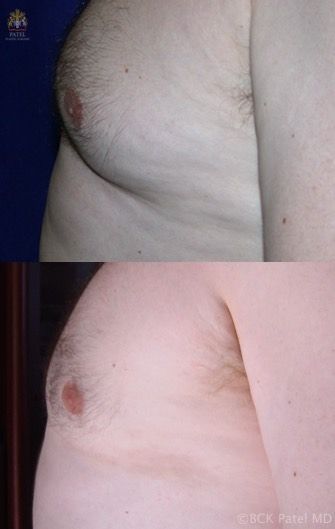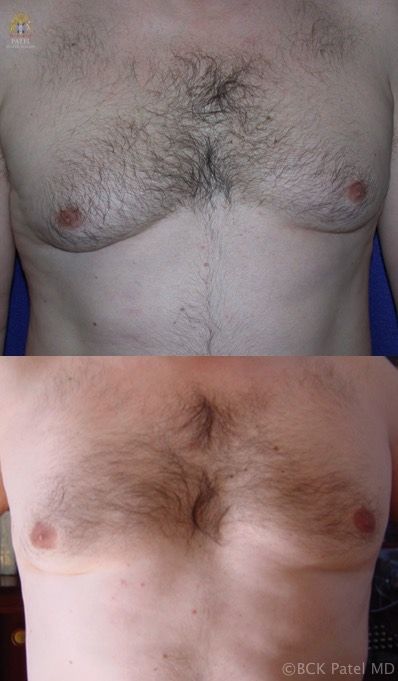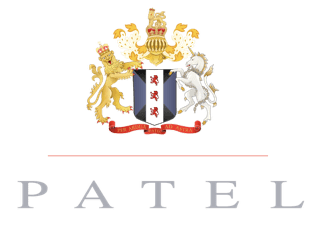MALE BREAST (GYNECOMASTIA) SURGERY-SALT LAKE CITY
MALE BREAST (GYNECOMASTIA) SURGERY SALT LAKE CITY
LOCAL ANAESTHESIA
NO HIDDEN FEES
DAY PROCEDURE
3D & VASER LIPOSCULPTURE ASSISTED
Gynecomastia, informally known as “man boobs”, is a relatively common condition affecting men of all age groups. It is associated with abnormally large and visible breast tissue. In the majority of cases, gynecomastia is not a serious problem. However, it may cause psychological distress, affecting self-confidence and causing social embarrassment. Some sufferers may also experience pain/discomfort.
At Medaesthetics® we treat several cases of gynecomastia each week. Images below are of actual Medaesthetics patients. Copyrights reserved.
Liposuction of Chest fat along with surgical excision of male breast tissue- Dr Ehsan Jadoon’s Patients ( Please click on the image).
Important: Any surgical or invasive procedure carries risks. Before proceeding, you should seek a second opinion from an appropriately qualified health practitioner. All images displayed on this website are property of Medaesthetics®. Formal Consent has been obtained from respective individual (where required) who’s images have been used. Before/after photos are of actual Medaesthetics® patients and are for reference purpose only. Individual results may vary.
Is Gynecomastia associated with being over weight?
True Gynecomastia is not caused by extra body fat from being overweight. It is caused by increase in the size of male breast tissue which is a fibrous, rubbery structure, different form fat. Therefore, doing exercise or losing weight often does not solve the problem in majority of cases.
What is Pseudo-Gynecomastia?
Pseudo-Gynecomastia is a relatively common condition where males have excess fat in the chest region giving the chest a feminine look (small breasts).
What are the signs and symptoms of gynecomastia?
Signs and symptoms may occur in one or both breasts.
The breast gland tissue swells.
The breast becomes tender.
The diameter of the areola increases, or the chest tissue becomes asymmetrical. (The areola is the ring of pigmented skin surrounding the nipple). Important: You should see the doctor if there is unusual and persistent swelling, tenderness, pain, and/or nipple discharge.
What are the causes of gynecomastia?
Gynecomastia may have several causes.
Hormonal imbalance between the sex hormones testosterone and oestrogen can makes breast tissue grow.Especially around puberty.
Swollen breasts become more common among males as they reach middle and old age. This is because older men produce less testosterone. Older males are usually fatter than young men, which results in more estrogen being produced.
- Alcohol abuse – alcohol abuse raises the risk of enlarged male breasts.
- Liver disease & Kidney failure
- Radiation treatmen of the testicles
- Klinefelter’s syndrome
- Infections or lumps in the testicles
- Thyroid gland disorders
- Medications – several medications can cause the breasts in men to enlarge, including:
1. Anabolic steroids – The single most common culprit
2. Certain antibiotics
3. Certain ulcer medications
4. Chemotherapy
5. Tricyclic antidepressants
6. Diazepam (Valium) and some other drugs for treating anxiety
7. Some HIV medications, including efavirenz (Sustiva)
8. Anti-androgens, commonly prescribed for patients with cancer or prostate enlargement
9. Some heart drugs, including calcium channel blockers and digoxin.
Diagnosing Gynecomastia
Gynecomastia is diagnosed, in majority of cases, by history and physical examination, accompanied by radiological investigations when required (Ultra Sound).
At Medaesthetics®, our doctors will ask the patient questions regarding symptoms, medical and drug history, and possibly family history.
A detailed physical examination is carried out.
If the doctor determines that gynecomastia is caused by a hormone imbalance, as may be the case during puberty in teenagers, the patient will be told to wait for a few years before considering surgical removal of the gland.
If the breast gland is lumpy, abnormally large, tender, one-sided, or fixed and hard; further investigation will probably be required, including a biopsy. The doctor needs to know whether there is a family history of breast cancer. For detailed workup, we will refer you back to your GP.
- A cyst
- Lipoma (benign tumor composed of body fat)
- Mastitis – inflammation of breast tissue
- Breast cancer (rare)
- Pseudogynecomastia – this is caused by fat, while gynecomastia is caused by fibrous breast tissue
- Hematoma – a solid swelling of clotted blood
- Metastasis – cancer that originated elsewhere in the body and has spread to the breast ( rare)
- Fat necrosis – a lump that forms as a result of damage to fatty breast tissue
- Hamartoma – a benign tumor-like growth
The doctor may order some blood tests and a mammogram. Depending on the results, further tests may be ordered, including:
- X-rays of the chest
- CT (computerized tomography) scan
- MRI (magnetic resonance imaging scan)
- Ultrasound scan of the testicles
- Tissue biopsy – a sample of cells or tissue is removed from the target area and is examined under a microscope by a pathologist
What are the treatment options for gynecomastia?
If your GP finds an underlying condition that is causing the gynecomastia, it needs to be treated first. If the gynecomastia appears to be caused by a medication, your GP may recommend switching to a different drug, discontinuing it, or carrying on. If the course of medication is not long-term, the condition will be temporary.
Teenagers with no apparent cause of the condition will be advised to come back periodically to see whether it improves on its own. If the condition does not resolve on its own within a couple of years, causes embarrassment, pain and/or tenderness, treatment may be necessary.
Treatment for gynecomastia may include medications such as hormone therapy to block the effects of estrogens, or breast reduction surgery.
Surgery for gynecomastia
At Medaesthetics®, we routinely perform in gynecomastia surgery as a day procedure without the need for hospital admission.
- Glandular tissue – which is firm and dense.
- Fatty tissue – which is soft.
The ratio of glandular to fatty tissue varies from patient to patient. In individuals with gynecomastia there may be too much of both types of tissue.
Liposuction – if there is too much fatty tissue, liposuction is used to eliminate it. We offer complimentary 3D Liposuction with each Gynecomastia surgery.
Excision – this means cutting out tissue with a scalpel. If the breast enlargement is caused by excess glandular tissue, it will need to be excised. This procedure will leave a scar, typically around the edge of the nipple. If a major reduction in tissue and skin is required, the surgeon will need to make a larger incision, resulting in a bigger scar.
The doctor may recommend both – excision in conjunction with liposuction.
What is involved in Gynecomastia Surgery?
At Medaesthetics®, all gynecomastia operations are performed under local anaesthesia. A specialised cocktail of anaesthetic solution is infiltrated into the treatment area and liposuction is performed using specialised vibrating cannulas to help break the fibrous tissue. Surgical excision of glandular breast tissue is carried out next and the small wound is then stitched.
Is it painful?
The procedure is performed under local anaesthesia and patients do not feel any pain or discomfort during the surgery. Oral pain killers are prescribed after the surgery to reduce any discomfort in the healing stage.
What is the recovery like?
After surgery the chest will be bruised and swollen, making it hard to determine how effective the operation has been. We always instruct the patient to wear an elastic pressure garment continuously for 2 weeks to help reduce swelling and to minimise haematoma (blood clot) formation.
It takes typically about 4 to 6 weeks before the patient is able to return to completely normal activities.
What are the complications?
Complications from surgery are rare, and may include:
- Not enough removal of breast tissue
- Infection
- Delayed wound healing
- The chest having an uneven contour
- Reduced sensation of the nipple(s).
- Surgery involving excision as well as liposuction, carries the risk of bleeding and blood clot formation in the treated area. This usually happens when patients fail to follow post surgery instructions to retrain from physical activity after surgery for at least first 7 days.
How much does it cost?
Cost of Gynecomastia surgery depends upon the extent of surgery required to fix the problem. As mentioned above, this may involve liposuction with or without excision of breast gland. Costs vary from $4500 to $6000 (all inclusive).
Quick Enquiry
Short on time? Simply send your enquiry here and we will get back to you with more information.







